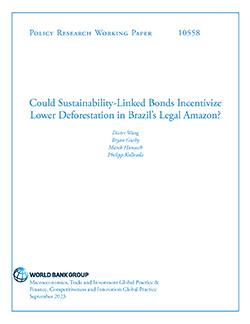Publications
New
Policy Research Working Paper
Protecting Forests in the Congo Basin : An Empirical Basis for Performance-Linked Financing for the Republic of Congo
The Republic of Congo, a country with extensive tropical forests and low deforestation rates, needs to balance export-driven development, especially through timber production, and sustainable forest management. Despite national commitments to conserve and restore forests, such efforts remain underfunded. Empirical analysis shows that historical deforestation is closely tied to timber and agricultural export prices, the real effective exchange rate, dry weather, and demographic trends. Under a business-as-usual scenario, deforestation could rise sharply without effective policy interventions. Sangha and Likouala provinces, which are rich in undisturbed forests and new concessions, are particularly at risk. Past oil-driven revenues have contributed to lower deforestation by shifting economic focus away from land-intensive activities; however, transitioning from oil dependency requires diversification into the forest sector which in turn requires strengthening sustainable logging practices and more robust institutional frameworks. This research provides a model-based benchmark to define key performance indicators for deforestation reductions and to set feasible and ambitious targets for protecting forests while pursuing diversified economic growth. Transparent performance indicators along with feasible, but ambitious targets are a critical for results-based financing instruments. They are critical to unlock public and private capital to support economic growth and conserve the standing forests. This model has relevance to the other Congo Basin and tropical forest countries with extensive forests.
Jul 21, 2025
Full report
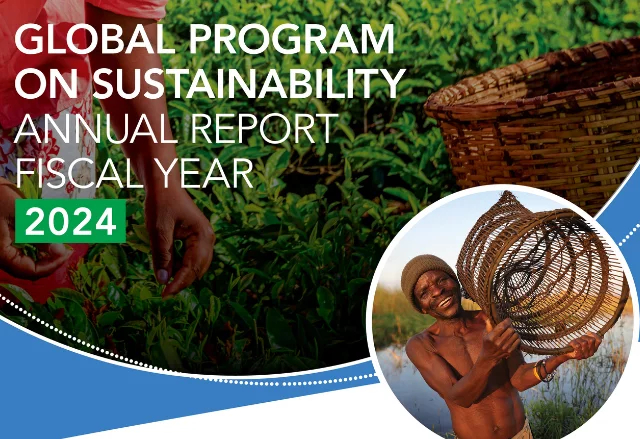
New
Report
GPS Annual Report
As we navigate accelerating and interlinked crises—from climate change, biodiversity loss, and pollution, to debt, rising cost-of-living, and conflict—it has never been more urgent to measure and value nature to make better decisions for development. Many people in developing countries depend on natural capital, such as forests, water, farmland, and soils, for jobs, raw materials, and food security. The Global Program for Sustainability (GPS) is at the forefront of global efforts to measure, quantify, and integrate nature and sustainability into economic decision-making to equip policy makers with the information they need to “make nature count” on balance sheets.
Feb 25, 2025
Full report
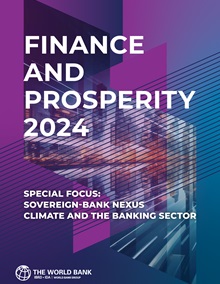
Report
Finance and Prosperity 2024
This inaugural edition analyzes new data and highlights a growing divergence in financial sector resilience and stability among emerging market and developing economies (EMDEs) and critical trends in climate finance.
While financial sector risks in the larger and higher per capita countries are moderate, half of lower-income countries face significant risks over the next 12 months. Nearly 70 percent of countries facing high financial sector risks are currently not adequately prepared to handle financial stress. The report also identifies a particular risk facing financial sectors in several countries: a large and growing exposure to sovereign debt. This exposure surged to its highest level in the past decade. Finally, the report looks at how countries can enable more climate finance through the banking sector without compromising on the important goals of financial sector stability and inclusion for underserved people.
Learn more about the critical role of finance in achieving prosperity for all in the Finance and Prosperity report.
Sep 25, 2024
Full report
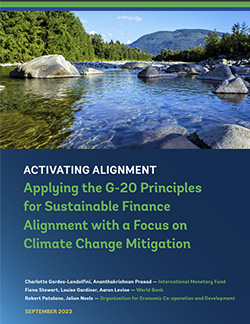
Report
Activating Alignment: Applying the G-20 Principles for Sustainable Finance Alignment with a Focus on Climate Change Mitigation
The first action in the G-20 Sustainable Finance Roadmap proposes six high-level principles for the development and global coordination of approaches to align investments with sustainability goals. “Alignment approaches” are national and international frameworks for the financial sector that aim to monitor global sustainable finance flows and ensure that they are contributing to the temperature goals of the Paris Agreement, the Sustainable Development Goals (SDGs), and other international sustainable finance objectives. These approaches increasingly leverage “alignment tools,” which include but are not limited to (a) taxonomies (or classifications) of private sector activities that can be labeled as achieving environmental and social objectives; (b) certifications and labels that confirm that products or services have met environmental, social, and governance (ESG) standards; (c) disclosure frameworks that guide private sector entities to manage and report on their ESG performance; and (d) transition frameworks that help the private sector design a credible shift to low-carbon technologies and practices. The tools can then be applied in different ways—ranging from national-level regulations to voluntary private sector—led initiatives, to corporate-level practices. The tools can be applied by investors and finance providers for different purposes at different levels: at the “asset level” (as in determining whether a project or activity is compatible with a relevant sustainable finance taxonomy or due diligence framework); the “entity level” (as inwhether a corporate or financial institution has a robust low-carbon transition plan and adheres to the International Labour Organization (ILO) Declaration on Fundamental Principles and Rights at Work); or “portfolio level” (as in whether an index is aligned with a credible temperature objective or supports poverty reduction). The G-20 Voluntary Principles for Developing Alignment Approaches provide a common foundation for ensuring these alignment approaches are robust and consistent.
Sep 26, 2023
Full report
Policy Research Working Paper
Could Sustainability-Linked Bonds Incentivize Lower Deforestation in Brazil’s Legal Amazon?
This paper proposes a new relative evaluation and benchmarking framework for performance-linked financing instruments. It argues that the carrots and sticks of sustainability-linked bonds should not use key performance indicators which are solely tied to outcomes. Instead, they should be based on its issuer's level of performance with respect to a target. The paper defines performance as the part of the outcome that the issuer can influence. Otherwise, the issuer may be rewarded or penalized for factors outside their control. In such a case, principal-agent theory would predict a dilution of the performance-based instrument's incentives. This framework is then applied to deforestation in Brazil's Legal Amazon and estimate performance by accounting for the real effective exchange rate, global commodity prices, and prevalent deforestation trends. The results show that policy efforts helped lower deforestation in the 2000s, even after accounting for external factors. The trend reversal and acceleration in deforestation since 2012 are partly due to weaker policy and macroeconomic factors. Based on these results, the paper proposes an Amazon sustainability-linked bond, which could allow for a more effective mechanism to incentivize policy efforts. The paper also introduces the feasibility and ambitiousness matrix to set sustainability performance targets. The matrix is used to define the terms low-hanging fruits and long shots and to discuss why such targets are subject to the risk of greenwashing.
Sep 04, 2023
Full report
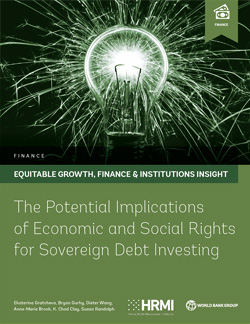
EFI Insight-Finance Report
The Potential Implications of Economic and Social Rights for Sovereign Debt Investing
This paper discusses both the relevance of economic and social rights (ESRs) for environmental, social, and governance (ESG) investing in the sovereign debt asset class and how to start incorporating these rights into the investment process in a practical way. Many in the investment industry recognize the potential role that investors can play in influencing a country’s decisions on environmental and social issues, including human rights. Investors are also increasingly acknowledging the potential to influence a sovereign’s actions on social issues, such as ESRs, given the state’s direct role in providing a pathway to social advancement for its citizens. The rest of this paper is organized as follows. Section 2 explains the relevance of ESRs to the sovereign debt asset class. Section 3 introduces the income adjusted ESR dataset, and section 4 illustrates the insights that this dataset can provide for sovereign debt investors. Section 5 provides one practical example of how sovereign debt investors could use such a dataset in practice. Section 6 presents our conclusions.
May 24, 2023
Data story
Full report
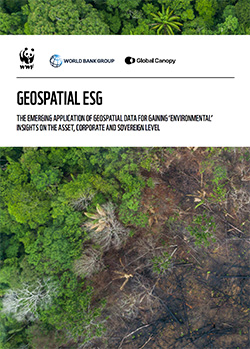
Report
Geospatial ESG
An ongoing challenge with Environmental, Social, and Governance (ESG) efforts is access to robust data. In response, commercial data providers are continually developing solutions to improve insight. Here the authors discuss one of these potential improvements: the use of geospatial data within ESG focusing on the environmental (E) aspect. Geospatial data can, and is, being used for social (S), and governance (G) purposes, but these are beyond the scope of this paper. This paper explores and tests with real-world examples the potential of geospatial data approaches as means to provide additional insights into the environmental impacts of specific assets, companies, states or nations for sovereign debt investment. Starting with the current data landscape, the document runs through the open ‘environmental’ geospatial data portfolio, outlining its strengths and weaknesses. From this vantage point, the report outlines three case studies in Brazil across differing scales, highlighting various key metrics. The first looks at an asset level example, mining operations; secondly a corporate level example looking at soya production (where asset data is unavailable); and finally a national scale example for sovereign debt insights. Throughout the paper, commercial actors provide technical illustrations as to what more would be possible with additional resources. The document demonstrates that it is possible, even with limited resources and only open data, to generate robust geospatial ESG insights that often can be scaled globally – aiding financial institutions to better differentiate environmental impact at different scales and across different applications The paper concludes by discussing the various future technical developments, highlighting real-world developments, such as eDNA and machine learning, and their implications for the future of geospatial ESG. Finally, the authors look at a breakdown of the critical components of geospatial ESG tools, showing where they fall on a spectrum, with most underutilizing the technical toolkit available. As a result of this potential technical growth, combined with greater demand from the financial sector, they expect to see a rapid development of more refined geospatial ESG products and insights in the near future.
Feb 24, 2022
Blog
Full report
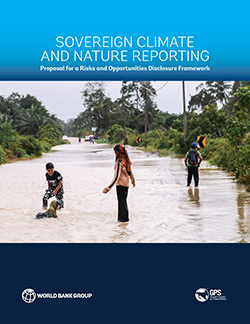
Report
Sovereign Climate and Nature Reporting: Proposal for a Risks and Opportunities Disclosure Framework
The purpose of this report is to raise awareness and initiate a discussion on the need for sovereign sustainability reporting. The proposed sovereign climate and nature reporting framework would assist sovereigns looking to attract investment by enabling them to produce comprehensive, regular, standardized, and, eventually, forward-looking disclosures of their climate- and nature related risks and opportunities. Sovereign reporting would help meet the needs of investors who are increasingly requesting such disclosures for all asset classes in their portfolios so that they can measure portfolio alignment with the Paris Agreement. This report discusses five fundamental questions regarding sovereign climate and nature reporting: (a) why is a sovereign reporting framework needed?; (b) what is required to develop a reporting framework for sovereigns?; (c) how is materiality important in driving a reporting framework for sovereigns?; (d) what is the potential for unintended consequences?; and (e) what are the recommended next steps to develop and implement a reporting framework for sovereigns? Sovereign reporting needs its own approach and framework. A customized approach suited to the specifics of sovereign reporting is recommended. This could build on the core elements and underlying principles of existing corporate-focused frameworks such as the Taskforce for Climate-related Financial Disclosure (TCFD). Other frameworks such as context-based performance accounting and reporting frameworks and environmental economic approaches could also be drawn upon, such as the UN System for Environmental Economic Accounting (SEEA) framework. Annex A to this report presents a draft example of a sovereign climate and nature risk and opportunities reporting framework as a starting point for discussion (noting that it is not intended as a fully developed template or blueprint).
Jan 31, 2022
Blog
Full report
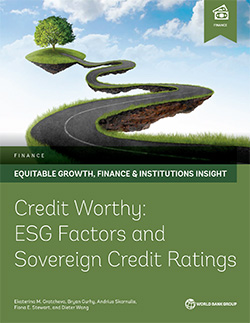
EFI Insight-Finance Report
Credit Worthy: ESG Factors and Sovereign Credit Ratings
The increasing role of the financial sector in the move toward a more sustainable economic model continues apace. The Coronavirus (COVID-19) shock shone a light on the need for all society to correct course, and the financial sector is responding. The pace of environmental, social, and governance (ESG) integration into investment decisions, which has become the prevalent form of sustainable finance, continues to accelerate. These developments reflect changing societal perspectives that challenge the traditionally ingrained investment approaches that have evolved over many decades. Against this backdrop, various financial sector stakeholders continue to evaluate how their role, products, and tools should adapt to this evolving landscape. This paper focuses on sovereign credit ratings and empirically assesses how broad sovereign ESG factors as well as the ESG factors specific to a country’s national wealth and management of risks and opportunities related to so-called stranded assets like fossil fuel resources are manifested in sovereign credit rating assessments.
Jan 01, 2022
Full report

Book chapter
The Changing Wealth of Nations: 2021 (Chapter 13)
Financial markets have started adopting sustainable development goals into mainstream discussions. Sovereign environmental, social, and governance (ESG) scores that guide sustainable finance have an ingrained income bias that potentially diverts capital flows toward richer countries at the expense of poorer countries. Comprehensive wealth data are uniquely suited to inform sovereign ESG because they (1) put a dollar value on natural assets, (2) adopt a forward-looking perspective, and (3) have a long history of curated data that are comparable across 23 years and 146 countries. The environmental pillar of sovereign ESG frameworks traditionally relies mostly on a resource’s environmental materiality (for example, forest cover) and less on its economic materiality (for example, forest wealth). As wealth measurement exceeds a mere stock-taking exercise and reflects the resource’s long-term economic benefits, it can complement environmental indicators for decision-makers. The adoption of wealth data has been constrained by their five-year frequency and late availability. This edition of The Changing Wealth of Nations (CWON) updates the frequency to annual and increases the potential applications of the data.
Nov 09, 2021
Full report

Report
Striking the Right Note: Key Performance Indicators for Sovereign Sustainability-Linked Bonds
The framework presented in the report is intended to bridge the gap between what sovereign investors will view as appropriately ambitious actions and what issuing countries see as achievable targets. The framework is intended to help investors with their decision-making and can inform Ministries of Finance and their debt management offices (DMOs) about what investors want to know regarding their country’s sustainability performance. The report findings may also inform creation of financial instruments and market analyses beyond sovereign sustainability-linked bonds (SLBs) and are relevant for a broad range of stakeholders. These include regulators, credit rating agencies, academics, as well as nongovernmental organizations (NGOs), and civil society groups which can be affected by the types of indicators selected and outcomes of government policies.
Nov 01, 2021
Blog
Full report
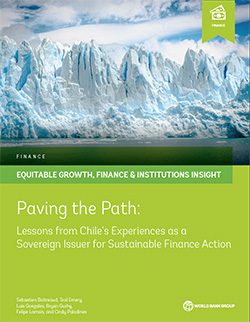
EFI Insight-Finance Report
Paving the Path: Lessons from Chile’s Experiences as a Sovereign Issuer for Sustainable Finance Action
Climate risks are on the rise globally. For emerging market countries such as Chile, these risks can manifest as an increased propensity for drought, wildfires, flood events, and landslides. As a result, governments are increasingly prioritizing policy solutions that will support an economic transition to mitigate the impact of climate change while also supporting households and communities as they adapt to the changing risk landscape. The financial sector is playing a key role in supporting a just economic transition. For many emerging market countries, the sovereign is the largest issuer of domestic debt, and the instruments and issuance path they choose can be key toward influencing downstream financial sector activity. For their part, global investors are becoming more attuned to the environmental, social, and governance (ESG) factors that underpin sovereign debt instruments. This report explores Chile’s sovereign issuer options, opportunities, and challenges through the lens of its recent decisions to issue green, social, and sustainable debt instruments.
May 24, 2021
Full report
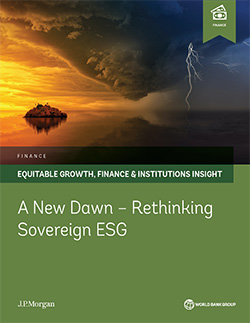
EFI Insight-Finance Report
New Dawn - Rethinking Sovereign ESG
Environmental, social, and governance (ESG) investing is quickly becoming ordre du jour in sovereign debt investing. There remains, however, lack of clarity around frameworks for scoring sovereign ESG performance, industry practices, and the definition of sustainability itself. This World Bank publication consists of two independent reports. The first part is written by the World Bank and takes stock of the current sovereign ESG investing framework and proposes improvements. The second part presents a survey on ESG practices among emerging market (EM) sovereign debt investors conducted by J.P. Morgan (JPM), which launched the first EM sovereign ESG index in 2018. This publication is a result of the World Bank~^!!^s proactive engagement with stakeholders on pertinent sovereign ESG issues and is part of a publication series under the auspices of the Global Program on Sustainability (GPS).
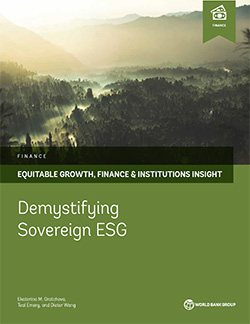
EFI Insight-Finance Report
Demystifying Sovereign ESG
The evolution of sustainable finance to mainstream finance has been motivated by a growing demand for the financial sector to play a greater role in the transformation of the current economic model into a more sustainable one. The introduction of the United Nation’s (UN) Sustainable Development Goals and the Paris Agreement on climate change in 2015 have helped galvanize a societal shift to ensure a sustainable future and to fight climate change in particular. As a result, the pace of environmental, social, and governance (ESG) integration, which has become the most prevalent form of sustainable finance, has accelerated in recent years. Market participants continue to grapple with adapting the ESG framework to the sovereign context, despite significant progress of ESG integration in the corporate bond and equity asset class. This challenge is due to the multifaceted nature of ESG-related issues facing governments in relation to corporate entities, as well as a more complex transmission mechanism of the sovereign debt asset class to sustainable outcomes in the real economy. This paper demystifies sovereign ESG as a distinct segment of the ESG sector by assessing the major sovereign ESG providers that have laid the foundation for the operationalization of ESG investing in sovereign fixed income markets.
May 20, 2021
Blog
Full report
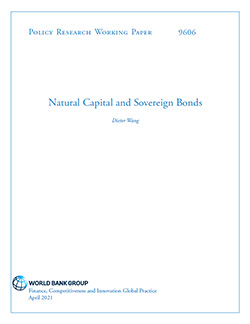
Policy Research Working Paper
Natural Capital and Sovereign Bonds
Natural capital is related to government bonds through the macroeconomy and credit risks. This paper estimates this relationship from the long-term, between-country view and the short-term, within-country view. The paper cautions against the former, as it is dominated by income differences. These are de facto ingrained, as they cannot be overcome by short-term policy efforts. The within-country view is unaffected by the ingrained income bias and leaves room for recent natural capital changes to affect bond yields. The paper finds that non-renewables (fossil fuels and mineral assets) raise bond yields, possibly due to the resource curse. Renewables (forests and agricultural wealth) lower borrowing costs because they are economically worthwhile investments. Protected areas are more likely to be luxury investments.
Apr 01, 2021
Full report
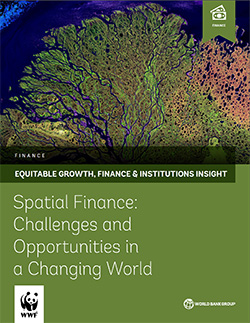
EFI Insight-Finance Report
Spatial Finance: Challenges and Opportunities in a Changing World
If financial markets are to realign towards truly sustainable development the financial sector needs to differentiate commercial actors more accurately on their climate and environmental performance. A potential breakthrough to help in this challenge is the emerging field of ‘Spatial Finance’, the independent assessment of the location of a company’s or a country’s assets and infrastructure using ground data, remote sensing observations and modelled insights, offers a potentially transformative means to gain improved quantitative ESG insights. Rapid development is required if spatial finance is to deliver in the short term. In this report, authors outline a possible taxonomy and hierarchy for spatial finance, showing how discrete forms of technology, approaches and data can be considered within a single consistent framework. Using this framework, spatial finance could provide insights at differing scales for different applications from the asset-scale for project finance, to company-scale for investment, to country scale for sovereign debt. Throughout the document authors provide insights into current cutting-edge developments within the field, illustrated with case studies from practitioners and data providers, and explore potential future developments.
Dec 01, 2020
Full report

EFI Insight-Finance Report
Riding the Wave: Navigating the ESG Landscape for Sovereign Debt Managers
The world is on an unsustainable path. Financial sector participants are becoming more conscious of the impact of their economic, social and environmental footprint. As the investor community makes progress towards integrating environment, social and governance (ESG) factors into investment mandates, particularly for equities and corporate debt, integrating these factors into the sovereign debt asset class has lagged- although investment practices and approaches are evolving. As the financial ecosystem changes, the Debt Management Office (DMO), as the main financing arm of the state, would benefit greatly from understanding how these changes affect the core Public Debt Management (PDM) mandate and how to respond to the growing investor demand for sustainable finance. The paper presents an overview of areas in which DMOs can respond to the changing world and proposes six ESG market readiness factors as well as a framework to help formulate DMO strategy in the area of ESG investing. The paper also concludes that in less developed markets, given weak institutional arrangements, it is often better to concentrate development efforts on the local capital market as this will ultimately support a more sustainable economy in the long run.
Oct 27, 2020
Executive summary
Full report


